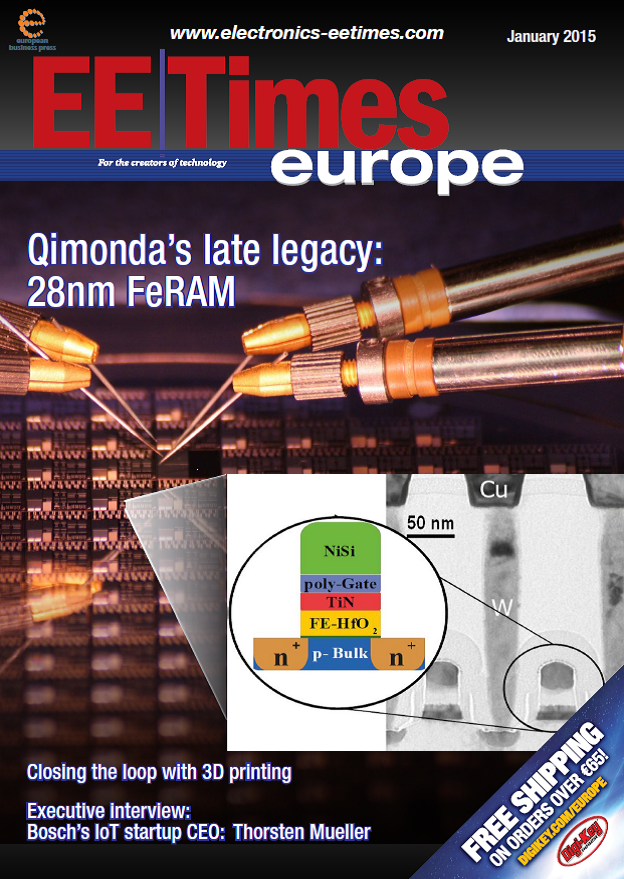J. Müller, P. Polakowski, S. Mueller and T. Mikolajick
ECS J. Solid State Sci. Technol.
2015
volume 4,
issue 5,
N30-N35
Abstract

Abstract
Bound
to complex perovskite systems, ferroelectric random access memory
(FRAM) suffers from limited CMOS-compatibility and
faces severe scaling issues in today's and future
technology nodes. Nevertheless, compared to its current-driven
non-volatile
memory contenders, the field-driven FRAM excels in
terms of low voltage operation and power consumption and therewith has
managed to claim embedded as well as stand-alone
niche markets. However, in order to overcome this restricted field of
application,
a material innovation is needed. With the ability
to engineer ferroelectricity in HfO2, a high-k dielectric
well established in memory and logic devices, a new material choice for
improved manufacturability and
scalability of future 1T and 1T-1C ferroelectric
memories has emerged. This paper reviews the recent progress in this
emerging
field and critically assesses its current and
future potential. Suitable memory concepts as well as new applications
will
be proposed accordingly. Moreover, an empirical
description of the ferroelectric stabilization in HfO2 will be given, from which additional dopants as well as alternative stabilization mechanism for this phenomenon can be derived.
Comparison of the two major flavors of FRAM. 1T-1C: (a) Working principle illustrating the sensing margin / switched polarization Psw derived from switched charge Qsw and non-switched polarization Pnsw in the P-E-hysteresis. (b) DRAM-like architecture of FRAM adding a plateline to word- and bitline for bipolar ferroelectric
switching. (c) TEM-micrograph and related P-E-hysteresis of a FE-HfO2
based deep trench capacitor array proving the concept of 3D-integration
capability. To illustrate the advantage of this area
enhancement, the polarization density is
calculated with respect to the lateral footprint of a comparable planar
capacitor. 1T:
(d) Illustration of the working principle by a graphical representation
of the charge neutrality condition in a MFIS stack.
Position 1 and 2 of the
insulator-semiconductor loadline represents the transition from the
ON-state to the OFF-state of the
FeFET or vice versa. Accordingly, the gate
voltage difference to turn on/off the FeFET can be approximated by 2 · VC = 2 · Ec · dFE, i.e. the memory window MW. (e) Disturb resilient AND architecture of the FeFET. (f) TEM-micrograph and related ID-VG-hysteresis of a FE-HfO2 based 28 nm high-k metal gate transistors proving the concept of advanced 1T FRAM scalability
The recent success of smartphones and tablet
computers has accelerated the R&D of fast and energy efficient
non-volatile semiconductor
memories, capable of replacing the conventional
SRAM-DRAM-Flash memory hierarchy. These so called emerging memories
usually
leverage on the fact that certain materials possess
the capacity for remembering their electric, magnetic or caloric
history.
For the extensively investigated ferroelectrics this
ability to memorize manifests in atomic dipoles switchable in an
external
electric field. This unique property renders them the
perfect electric switch for semiconductor memories. Consequently, only
a few years after the realization of a working
transistor the first ferroelectric memory concepts were proposed.
However, more than 60 years and several
iterations later it is now clear that the success or failure of FRAM is
mainly determined
by the proper choice and engineering of the
ferroelectric material. Perovskite ferroelectrics and related electrode
systems
underwent an extensive optimization process to meet
the requirements of CMOS integration and are now considered the front
up solution in FRAM manufacturing. Nevertheless, those
perovskite systems require complex integration schemes and pose scaling
limitations on 1T and 1T-1C memory cells that until
now remain unsolved. This creates an unbalance between memory
performance
on the one side and manufacturing and R&D costs on
the other side. This dilemma has ever since restricted FRAM to niche
markets.
With the recent demonstration of ferroelectricity in HfO2-based systems (FE-HfO2) a CMOS-compatible, highly scalable and manufacturable contender has emerged, that significantly expands the material choice
for 1T and 1T-1C ferroelectric memory solutions as well as nanoscale ferroelectric devices.
In this paper we will review and expand the current understanding of ferroelectricity in HfO2, as well as discuss future prospects of ferroelectric HfO2-based devices with respect to scaling, reliability and manufacturability. Opportunities and drawbacks of this disruptive
development in ferroelectric material science will be critically examined.
Continue reading in the full paper with Open Access here.



%20(1).png)




